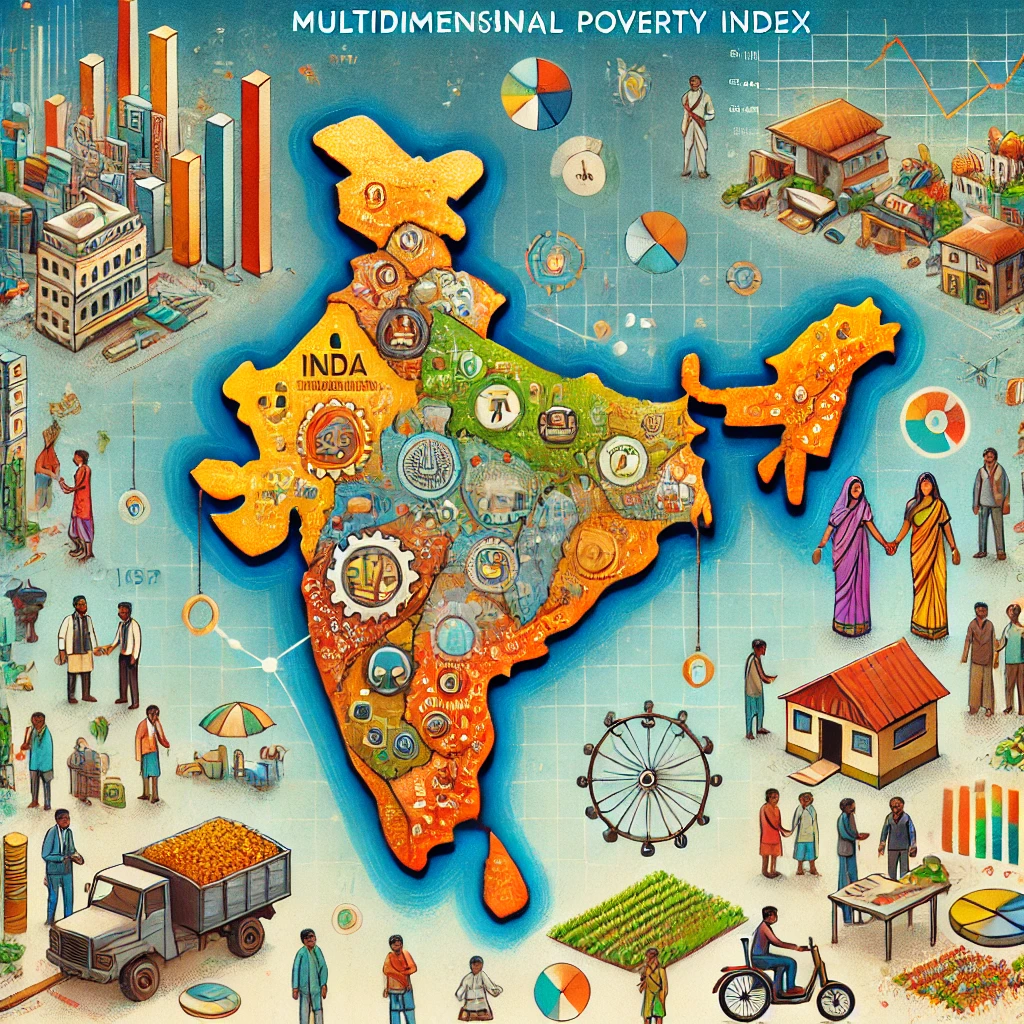In recent evaluations, the Multidimensional Poverty Index (MPI), known for measuring poverty’s multifaceted nature, has come under scrutiny for its methodological and conceptual inconsistencies, particularly during the NDA’s tenure. Esteemed for its comprehensive approach, the MPI assesses deprivation across health, education, and living standards. However, recent data from 2023 showing a reduction in India’s MPI values from 24.85% to 14.96% within four years has raised doubts. This sharp decline, suggesting a rapid pace of poverty alleviation, seems to overlook the socioeconomic upheavals caused by the COVID-19 pandemic. Critics call for a reevaluation of the MPI’s calculation mechanisms to include overlooked dimensions such as social exclusion and environmental degradation.
- Rapid Reduction Claims: Questions the validity of the sharp decline in MPI values, suggesting an overly optimistic portrayal of poverty reduction.
- Impact of COVID-19 Overlooked: Highlights the disregard for the pandemic’s socioeconomic disruptions in MPI calculations.
- Methodological Concerns: Points out issues with uniform weighting and data source limitations, suggesting a skewed understanding of poverty.
- Call for Comprehensive Measures: Advocates for the inclusion of overlooked dimensions such as social exclusion for a more holistic poverty index.
Relevancy for UPSC Aspirants
This editorial is highly relevant for UPSC aspirants as it delves into the complexities of the Multidimensional Poverty Index (MPI) and its broader implications in understanding poverty beyond mere income measures.
Educational Insights
- Amartya Sen’s Capability Approach: Explores the foundation of the MPI, emphasizing the importance of capabilities over mere income.
- Multidimensional Poverty Index (MPI) vs Human Development Index (HDI): Offers a comparative analysis, enhancing understanding of human well-being assessment.
- Data Sources: Discusses the use of National Sample Survey (NSS) and National Family Health Survey (NFHS) data in poverty measurement.
- COVID-19 Impact: Examines how the pandemic has exacerbated poverty, a crucial area for policy response.
- MPI Calculation Flaws and Improvements: Encourages critical thinking about the reliability of data and the effectiveness of poverty alleviation measures.
Significance of Multidimensional Poverty Index in National Discourse
The Multidimensional Poverty Index (MPI) has become a central topic in national discourse, extending beyond academic discussions to influence policy-making. This conversation is critical as it evaluates the methodologies used to assess poverty and challenges traditional income-based metrics.
Broader Implications
- Capability Approach: Focuses on the real freedoms and opportunities individuals have, which is essential for a holistic understanding of poverty.
- Functionings and Capabilities: Differentiates between actual states of being and the potential choices available to individuals.
- Beyond Income: Advocates for a multidimensional view of poverty, emphasizing development goals that expand capabilities.
- UPSC Relevance: Enhances UPSC aspirants’ understanding of poverty measurement, crucial for future policy-making roles.

Methodological Insights: Dissecting the Flaws in MPI Calculation
The critique of MPI’s methodology highlights the need for ongoing refinement to better represent the realities of those living in deprivation.
Critical Evaluation
- Uniform Weighting: Discusses the potential oversimplification in the MPI’s current framework.
- Data Reliability: Raises concerns about the adequacy of primary data sources like the NFHS.
- Methodological Debate: Encourages a critical evaluation of how poverty is measured.
- Refinement Needed: Points to the necessity for methodological improvements.
The Impact of COVID-19 on Poverty Metrics
The omission of the COVID-19 pandemic’s impact in poverty metrics like the MPI raises significant concerns about the accuracy and relevance of these measures during such unprecedented times.
Pandemic’s Role
- Exacerbation of Poverty: Highlights how the pandemic has deepened poverty and caused significant economic disruptions.
- Measurement Challenges: Discusses the limitations in current poverty metrics that fail to account for dynamic global events.
- Policy Implications: Stresses the need for adaptable interventions that address these extensive consequences.
Enhancing the MPI
- Incorporate Income Fluctuations: Suggests adapting the MPI to better reflect economic realities, such as income fluctuations and urban-rural migration dynamics.
- Value Education and Healthcare: Acknowledges the significant role of educational and healthcare expenditures in reducing poverty.
- Policy-Oriented Solutions: Encourages informed and evidence-based policy recommendations.
The critique and discussion surrounding the MPI and its methodology highlight the urgent need for a nuanced and accurate measure of poverty. For UPSC aspirants, understanding and addressing these challenges is pivotal in shaping their future roles in policy-making and governance.
Conclusion
This discussion is a call to action for UPSC aspirants to engage deeply with the complexities of poverty measurement and to advocate for more dynamic and inclusive measures that capture the multifaceted nature of deprivation.
